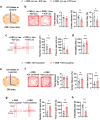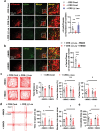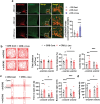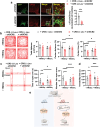Leucine deprivation results in antidepressant effects via GCN2 in AgRP neurons
- PMID: 39872511
- PMCID: PMC11748975
- DOI: 10.1093/lifemeta/load004
Leucine deprivation results in antidepressant effects via GCN2 in AgRP neurons
Abstract
Essential amino acids (EAAs) are crucial nutrients, whose levels change in rodents and patients with depression. However, how the levels of a single EAA affects depressive behaviors remains elusive. Here, we demonstrate that although deprivation of the EAA leucine has no effect in unstressed mice, it remarkably reverses the depression-like behaviors induced by chronic restraint stress (CRS). This beneficial effect is independent of feeding and is applicable to the dietary deficiency of other EAAs. Furthermore, the effect of leucine deprivation is suppressed by central injection of leucine or mimicked by central injection of leucinol. Moreover, hypothalamic agouti-related peptide (AgRP) neural activity changes during CRS and leucine deprivation, and chemogenetically inhibiting AgRP neurons eliminates the antidepressant effects of leucine deprivation. Finally, the leucine deprivation-regulated behavioral effects are mediated by amino acid sensor general control non-derepressible 2 (GCN2) in AgRP neurons. Taken together, our results suggest a new drug target and/or dietary intervention for the reduction of depressive symptoms.
Keywords: AgRP neurons; GCN2; amino acid sensing; depression; leucine deprivation.
© The Author(s) 2023. Published by Oxford University Press on behalf of Higher Education Press.
Conflict of interest statement
The authors declare that no conflict of interest exists. F.G. holds the position of Editorial Board Member for Life Metabolism, and is blinded from reviewing or making decisions for the manuscript.
Figures






References
-
- Malhi GS, Mann JJ.. Depression. Lancet 2018; 392:2299–312. - PubMed
-
- Fan KQ, Li YY, Wang HLet al. . Stress-induced metabolic disorder in peripheral CD4+ T cells leads to anxiety-like behavior. Cell 2019;179:864–79.e19. - PubMed
-
- Otte C, Gold SM, Penninx BWet al. . Major depressive disorder. Nat Rev Dis Primers 2016;2:16065. - PubMed
-
- Sabella D. Antidepressant medications. Am J Nurs 2018;118:52–9. - PubMed
LinkOut - more resources
Full Text Sources
